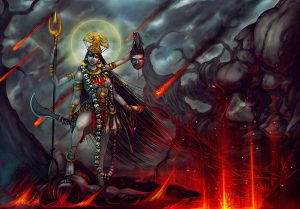In the vast tapestry of Hinduism, Kali Mata, the Hindu goddess of time, change, and liberation, stands out as a fiercely enigmatic figure. Known for her dark, fearsome appearance and divine power, Kali has captivated the minds and hearts of devotees for centuries.
In the eyes of Westerners, Kali is a mysterious goddess of death and destruction. However, her story is too extensive to fit into the typical Western narrative of good versus evil. The limitations of the physical world such as color, light, good and evil do not apply to her. Since she is a symbol of Mother Nature herself; she is primitive, nurturing, and helpful. In this aspect, she is referred to as Kali Mata or Kali Mother.
The Origins of Kali
The origin of Kali can be traced back to the ancient Indian scriptures known as the Puranas. One popular story describes her emergence during a cosmic battle between the gods and demons. When the malevolent demon Raktabija threatened to conquer the universe, the goddess Durga summoned Kali to aid her in the fight. As Kali Mata stepped onto the battlefield, she devoured the demon’s many manifestations and drank his blood, ensuring his destruction. Kali’s victory dance grew so intense in the aftermath that the other gods feared she would destroy the world. Only when Lord Shiva lay down before her did she come to her senses and cease her wild dance.
Life Lessons from Kali Mata

Since the gods could not cope with the savage demons ruling the world, they summoned a force that was at least as wild as them – Kali. That’s why Kali engaged in a legendary battle with the demon Raktabija, where every time he was attacked, more demons were born from his gushing blood. That’s why Kali drank all of his blood, making sure that none of the blood drops fell to the ground. She concluded that no demon would threaten the world. Although she responds to dark actions with dark actions, Kali’s main purpose is always to “protect”.
In charge of purifying harmful things, Kali’s place is cremation areas and her mount is a jackal. Her nudity should be considered as liberation from illusion. Representing both the power of creation and destruction. Kali’s dual nature leads her to face the reality of life and death, with the understanding that one cannot exist without the other. From another angle, it is a dramatic expression of a mother’s fierce, protective love for her children. Although her destructive power is enormous, she never harms the innocent and always protects her children. However, she will continue to challenge anyone who tries to tame her, as she has done since the beginning of time.
Symbols of Kali Mata
Kali’s appearance is both awe-inspiring and fear-inducing. Her black or dark blue skin symbolizes the infinite cosmic darkness from which all creation emerges and ultimately dissolves. Clad in a garland of severed heads and a skirt of dismembered arms, Kali Mata embodies the cycle of life, death, and rebirth. In her four hands, she carries various powerful symbols:
- A severed head – representing the ego, the root of all suffering, which must be severed for liberation.
- A sword – a tool for cutting through illusions and ignorance.
- A trident – symbolizing the threefold nature of creation, preservation, and destruction.
- A bowl – to collect the blood of the severed ego and demonic forces, signifying the purification of the soul.
Kali’s Influence in the Modern World
While Kali’s fearsome visage might seem at odds with modern sensibilities, her message of liberation and transformation remains deeply relevant. In a world of constant change and upheaval, Kali Mata serves as a reminder of the impermanence of all things and the necessity of embracing the darkness within ourselves to achieve spiritual growth.

Kali’s influence has also extended to various art, literature, and music forms, with her story being reinterpreted and shared across diverse cultures. She has been adopted as a symbol of empowerment, particularly for women, due to her ability to defy societal norms and assert her fierce independence.
Kali Yuga – The Age of Darkness
In the Hindu cosmological framework, the Kali Yuga is the final and darkest of the four cyclical ages, or Yugas, that comprise the world’s existence. The Kali Yuga is characterized by a decline in spirituality, ethics, and moral values, resulting in a society steeped in strife and discord. It is said that human virtues and righteousness deteriorate during this age, and the world becomes increasingly chaotic and materialistic. Interestingly, Kali Yuga shares its name with the goddess Kali, but the connection between them is etymological rather than symbolic.
The term “Kali” in Kali Yuga means “strife” or “discord,” reflecting the age’s tumultuous nature. Nonetheless, some devotees of Kali view her as a beacon of hope in these troubled times, believing that her fierce energy can help guide humanity through the darkness of this age and eventually usher in a new era of spiritual awakening and harmony. By acknowledging the challenges of the Kali Yuga, we can better appreciate the transformative power of Kali and her potential to inspire change and renewal amidst the chaos.
The Hindu goddess Kali continues to inspire and challenge devotees worldwide. By exploring her origins, symbols, and influence on the modern world, we can better understand the transformative power of embracing our inner darkness and the inevitable cycles of change. Through Kali, we are reminded that liberation lies not in the avoidance of darkness but in the courage to face it head-on and emerge transformed.
